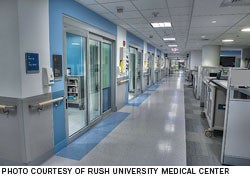New emergency response center raises care level
 When Dino Rumoro, D.O., talks about the new Robert R. McCormick Foundation Center for Advanced Emergency Response at the recently expanded Rush University Medical Center, Chicago, he speaks with understandable pride and passion.
When Dino Rumoro, D.O., talks about the new Robert R. McCormick Foundation Center for Advanced Emergency Response at the recently expanded Rush University Medical Center, Chicago, he speaks with understandable pride and passion.
The first-of-its-kind emergency response center is the result of a vision Rumoro, chairman of emergency medicine at Rush, had that dates to Sept. 11, 2001, when the definition of mass casualties and emergency response changed forever.
The 40,000-square-foot response center houses an expanded emergency department with 60 treatment bays and a surge capacity of 133 percent. The center contains three interconnected pods or sections, each capable of isolation to help prevent the spread of disease.
There also are designated individual isolation patient rooms within each pod. Airflow in the patient rooms, the pods and even entire sections in the patient tower can be controlled to help prevent the spread of infectious agents.
The center has decontamination showers built into the new emergency facility. In the event of a large-scale emergency, the enclosed ambulance bay can be converted into a large decontamination room where a water curtain can be created with hydrants to wash off patients before they enter the facility.
In a mass casualty, chemical-based industrial accident or terrorism attack, Rush can serve and decontaminate several hundred patients at once. On a daily basis, the new facility will stand as a traditional emergency room.
To access a podcast on Rush's emergency response center, click here.




